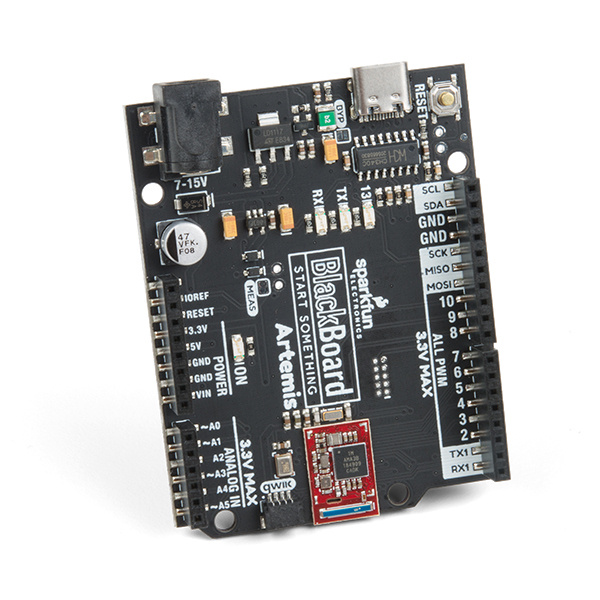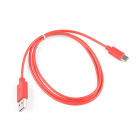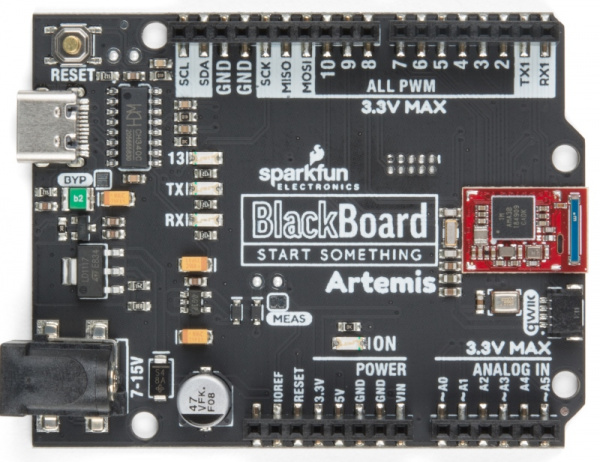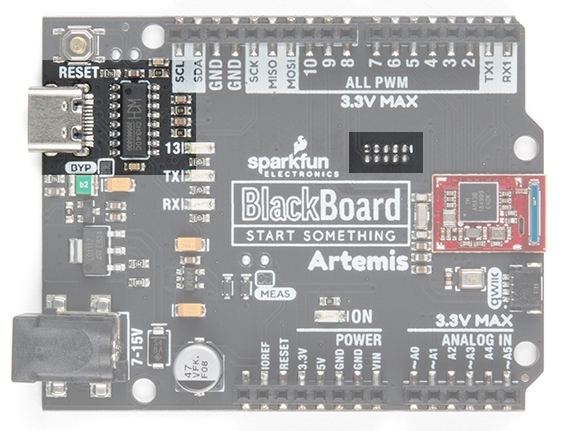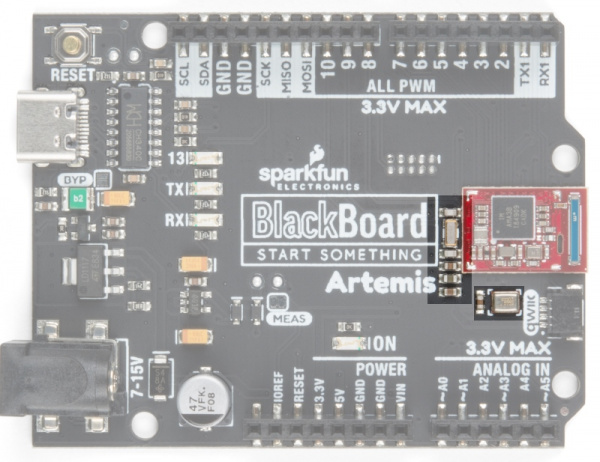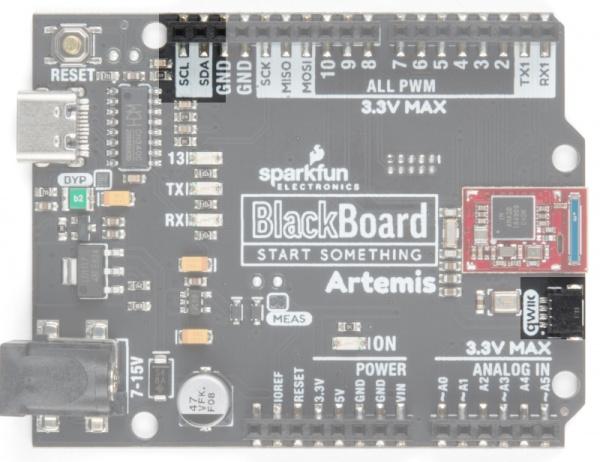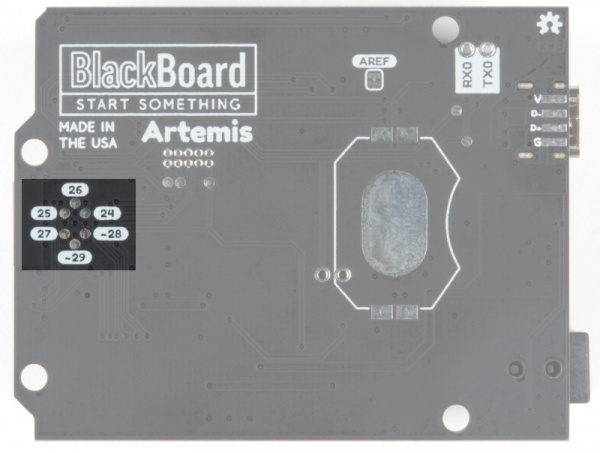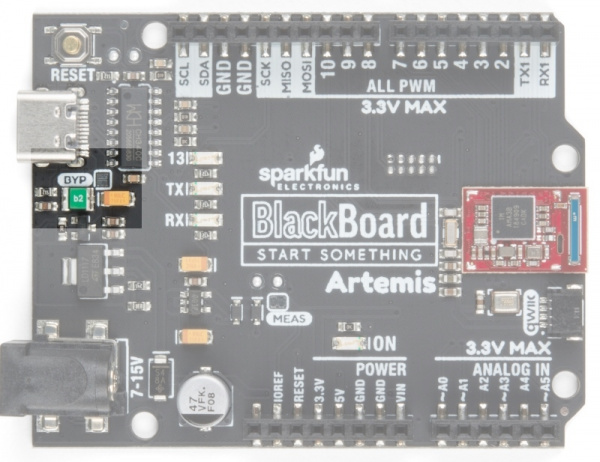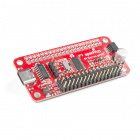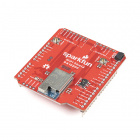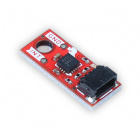Hookup Guide for the BlackBoard Artemis
This Tutorial is Retired!
View the updated tutorial: Hookup Guide for the SparkFun RedBoard Artemis
Introduction
The BlackBoard Artemis encapsulates all the lessons we've learned through the years of improving on the original Arduino Uno while adding in the powerful Artemis module so that you can easily use the Cortex-M4F. Let's dive in!
BlackBoard Artemis
SPX-15332Required Materials
You'll need the BlackBoard Artemis and a USB C cable. Any USB C cable should work, including the one that probably came with your phone charger.
USB 2.0 Cable A to C - 3 Foot
CAB-15092BlackBoard Artemis
SPX-15332Suggested Reading
If you aren't familiar with the Qwiic system, we recommend reading here for an overview.
 |
| Qwiic Connect System |
We also recommend checking out these tutorials before continuing:
I2C
RedBoard Qwiic Hookup Guide
Using SparkFun Edge Board with Ambiq Apollo3 SDK
Designing with the SparkFun Artemis
Artemis Development with Arduino
Hardware Overview
If you've ever used an Arduino Uno before you should be pretty familiar with the various female headers and the barrel jack power. If you're new to Arduino boards, check out the SparkFun RedBoard Qwiic tutorial for more information on many of the basic board functions you'll see on the Artemis BlackBoard. In this tutorial we'll be covering the unique aspects of the BlackBoard Artemis.
The ADC on the Artemis is 0-2V. Exposing an ADC pin to 3.3V will not harm the device but the ADC will saturate returning 16,383 (14-bit) for voltages greater than 2V.
Serial and JTAG Programming
The BlackBoard Artemis has two methods for programming. The most common is the USB C connector that operates as a USB to serial bridge. By simply pressing 'Upload' in the Arduino IDE or 'make bootload' from the SDK the firmware on Artemis is updated.
We use the CH340C on the BlackBoard Artemis. The driver should automatically install on most operating systems. However, there is a wide range of operating systems out there. You may need to install drivers the first time you connect the chip to your computer's USB port or when there are operating system updates. For more information, check out our How to Install CH340 Drivers Tutorial.
How to Install CH340 Drivers
The second method is JTAG programming. An unpopulated JTAG footprint is available for more advanced users who need breakpoint level debugging. We recommend checking out our JTAG section for the compatible male header and a compatible JTAG programmer and debugger.
Mic and RTC
The Artemis exceeds at low power voice recognition. To enable this we've included a PDM MEMS microphone on the board. Additionally, the Artemis module can operate an RTC given an external 32kHz crystal so we've included that was well.
Qwiic and I2C
The I2C pins on the Artemis are labeled SDA and SCL. They are controlled in the Arduino IDE using Wire.begin(), Wire.read(), etc. The same SDA/SCL pins are connected to the Qwiic connector so you can use SparkFun's Qwiic ecosystem (there's over 50 boards and more every week!).
Serial0, AREF, and USB Pads
On the rear of the BlackBoard are some advanced features. Normally, an AREF pin is located between to the SDA and GND pins. The Artemis module has no equivalent pin so we've converted that pin to GND. If you have a shield that utilizes the AREF pin or just want to free it, you can cut the AREF jumper and the labeled 'GND' located between SDA and GND will be left disconnected.
On Artemis, TX0/RX0 are used for bootloading new code and Serial.println() statements to the computer's terminal window. The CH340C takes care of the serial to USB conversion. However, if you need access to these pins, they're available. TX0/RX0 can be used as GPIO as well as special functions, but for most applications these pins are left as Serial for bootloading.
For users who are embedding the BlackBoard Artemis into an enclosure the USB pads are exposed so that an external USB connector can be located at the edge of the enclosure and wired back to the USB pads.
Busmaster Pads
One amazing aspect of the Artemis is the large number of SPI and I2C buses available. We at SparkFun decided that it would be better to have more PWM and ADC pins routed to the female headers on the front of the board, rather than extra I2C and SPI pins. But we just couldn't resist! We've made Wire1/SPI1 and Wire3/SPI3 available to users through the SMD pads on the bottom of the board. These pins can be used as GPIO if needed and pins 28/29 are PWM enabled as well.
Current Measurement Jumper
The Artemis can run as low as 6μA/MHz meaning the module can run at 48MHz at less than half a milliamp. To enable measurements and to isolate the power hungry devices (such as the LM317 voltage regulator) we've added a NC (normally closed) jumper. By cutting the jumper the VDD trace to the module is interrupted. Soldering in a male jumper or wires into the accompanying holes will give you the ability to insert a current meter and precisely monitor how much current your application is consuming.
For the vast majority of projects a wall adapter or USB power can be used. But when properly isolated the Artemis can run on a coincell battery for weeks! So we've designed in a 20mm SMD coin cell footprint so that users can experiment with powering the Artemis from a standard CR2032. You can pickup the compatible coincell holder here.
Bypass Jumper
USB C is wonderful. It's reversible and can source up to 2 amps at 5 volts without any power delivery (PD) negotiation. We've included a 2A resettable fuse (often called a PTC) on the Artemis as a safety feature in case your project decides to consume inordinate amounts of power (And possibly begins to spark and set fire. That was fun wasn't it? Get it? SparkFun?). In the event the BlackBoard begins to pull more than 2 amps from the USB source, the resettable fuse will automatically trigger and disconnect the board from the computer or power supply. This should protect your power source and the traces on your BlackBoard.
However, there are plenty of legitimate projects that need more than 2A. We've designed the power traces to withstand up to 2A with a 10C rise in temperature. If your power supply can provide adequate power, and you know what you are doing, you can close the BYP jumper circumventing the resettable fuse.
Software Setup
The BlackBoard Artemis runs both Arduino and the more advanced Ambiq HAL/SDK. Checkout these tutorials to get you up and blinking in 5 minutes!
Artemis Development with Arduino
Using SparkFun Edge Board with Ambiq Apollo3 SDK
Troubleshooting
If your product is not working as you expected or you need technical assistance or information, head on over to the SparkFun Technical Assistance page for some initial troubleshooting.
If you don't find what you need there, the SparkFun Forums are a great place to find and ask for help. If this is your first visit, you'll need to create a Forum Account to search product forums and post questions.
SparkFun Artemis Forums
Resources and Going Further
Did you know you can use the BlackBoard Artemis as the starting point of your very own Artemis product? Get the design files from our repo here and edit them using Eagle PCB!
For more information on the BlackBoard Artemis and the Artemis module itself, check out the links below:
- Schematic (PDF)
- Eagle Files (ZIP)
- BlackBoard Artemis Graphical DataSheet (PDF)
- Artemis Module Graphical DataSheet (PDF)
- Arduino Core
- Artemis Info Page
- GitHub Hardware Repo
- Apollo3 DataSheet (PDF)
- CH340E USB to serial IC Drivers
You've now explored the board, let's get blinking with Arduino! Or perhaps you want to learn a little more about the Artemis module itself. Checkout these tutorials!
Designing with the SparkFun Artemis
Artemis Development with Arduino
Did you know the Artemis is compatible with our Qwiic line? Checkout these products that simply plug in and work!
